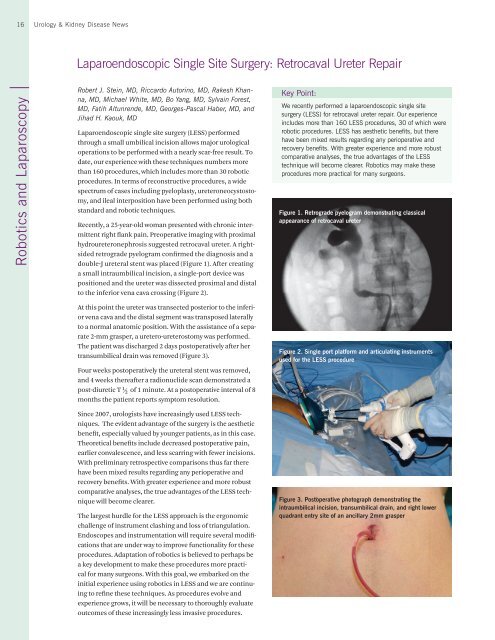Urology & Kidney Disease News - Cleveland Clinic
Urology & Kidney Disease News - Cleveland Clinic
Urology & Kidney Disease News - Cleveland Clinic
You also want an ePaper? Increase the reach of your titles
YUMPU automatically turns print PDFs into web optimized ePapers that Google loves.
16 <strong>Urology</strong> & <strong>Kidney</strong> <strong>Disease</strong> <strong>News</strong><br />
Robotics and Laparoscopy<br />
Laparoendoscopic Single Site Surgery: Retrocaval Ureter Repair<br />
Robert J. Stein, MD, Riccardo Autorino, MD, Rakesh Khanna,<br />
MD, Michael White, MD, Bo Yang, MD, Sylvain Forest,<br />
MD, Fatih Altunrende, MD, Georges-Pascal Haber, MD, and<br />
Jihad H. Kaouk, MD<br />
Laparoendoscopic single site surgery (LESS) performed<br />
through a small umbilical incision allows major urological<br />
operations to be performed with a nearly scar-free result. To<br />
date, our experience with these techniques numbers more<br />
than 160 procedures, which includes more than 30 robotic<br />
procedures. In terms of reconstructive procedures, a wide<br />
spectrum of cases including pyeloplasty, ureteroneocystostomy,<br />
and ileal interposition have been performed using both<br />
standard and robotic techniques.<br />
Recently, a 25-year-old woman presented with chronic intermittent<br />
right flank pain. Preoperative imaging with proximal<br />
hydroureteronephrosis suggested retrocaval ureter. A rightsided<br />
retrograde pyelogram confirmed the diagnosis and a<br />
double-J ureteral stent was placed (Figure 1). After creating<br />
a small intraumbilical incision, a single-port device was<br />
positioned and the ureter was dissected proximal and distal<br />
to the inferior vena cava crossing (Figure 2).<br />
At this point the ureter was transected posterior to the inferior<br />
vena cava and the distal segment was transposed laterally<br />
to a normal anatomic position. With the assistance of a separate<br />
2-mm grasper, a uretero-ureterostomy was performed.<br />
The patient was discharged 2 days postoperatively after her<br />
transumbilical drain was removed (Figure 3).<br />
Four weeks postoperatively the ureteral stent was removed,<br />
and 4 weeks thereafter a radionuclide scan demonstrated a<br />
post-diuretic T ½ of 1 minute. At a postoperative interval of 8<br />
months the patient reports symptom resolution.<br />
Since 2007, urologists have increasingly used LESS techniques.<br />
The evident advantage of the surgery is the aesthetic<br />
benefit, especially valued by younger patients, as in this case.<br />
Theoretical benefits include decreased postoperative pain,<br />
earlier convalescence, and less scarring with fewer incisions.<br />
With preliminary retrospective comparisons thus far there<br />
have been mixed results regarding any perioperative and<br />
recovery benefits. With greater experience and more robust<br />
comparative analyses, the true advantages of the LESS technique<br />
will become clearer.<br />
The largest hurdle for the LESS approach is the ergonomic<br />
challenge of instrument clashing and loss of triangulation.<br />
Endoscopes and instrumentation will require several modifications<br />
that are under way to improve functionality for these<br />
procedures. Adaptation of robotics is believed to perhaps be<br />
a key development to make these procedures more practical<br />
for many surgeons. With this goal, we embarked on the<br />
initial experience using robotics in LESS and we are continuing<br />
to refine these techniques. As procedures evolve and<br />
experience grows, it will be necessary to thoroughly evaluate<br />
outcomes of these increasingly less invasive procedures.<br />
Key Point:<br />
We recently performed a laparoendoscopic single site<br />
surgery (LESS) for retrocaval ureter repair. Our experience<br />
includes more than 160 LESS procedures, 30 of which were<br />
robotic procedures. LESS has aesthetic benefits, but there<br />
have been mixed results regarding any perioperative and<br />
recovery benefits. With greater experience and more robust<br />
comparative analyses, the true advantages of the LESS<br />
technique will become clearer. Robotics may make these<br />
procedures more practical for many surgeons.<br />
Figure 1. Retrograde pyelogram demonstrating classical<br />
appearance of retrocaval ureter<br />
Figure 2. Single port platform and articulating instruments<br />
used for the LESS procedure<br />
Figure 3. Postoperative photograph demonstrating the<br />
intraumbilical incision, transumbilical drain, and right lower<br />
quadrant entry site of an ancillary 2mm grasper

















